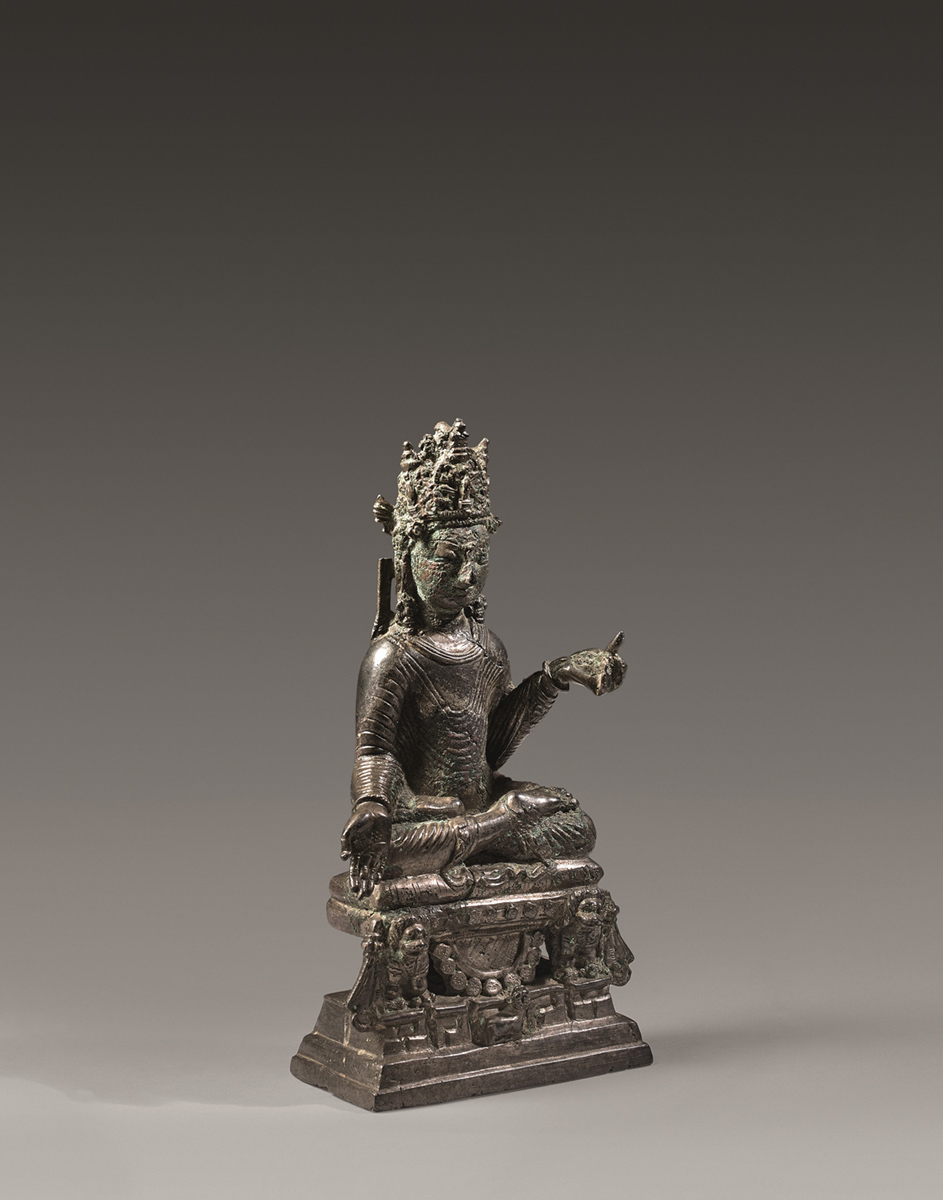

|
Swat Valley Circa 10th century Bronze H. 17 cm or 6 ½ in |

Detail: alternate view #2 Mahāyāna Buddhism multiplied the number of Buddhas, associating some of them with a specific geographic region, for example the West for Amitābha. As of the 7th century, a new spiritual school, Vajrāyana, systematized these concepts and placed five transcendent Buddhas at the top of its pantheon, calling them “jina” (vanquishers) or “tathāgata” (those who are in that manner). They are depicted as glorious bodies (Saṁbhogākaya: literally “bodies of ecstasy”) in the Buddhist heavens, an abstract place outside of the phenomenal world, inhabited by bodhisattvas and various transcendent entities. It is also in this form that they may appear to those who meditate. Three ancient works are partially or solely dedicated to the five jina. Most of the Guhyasamāja tantra, The Tantra of the meeting of the secret – also called Tathāgataguhyaka sūtra, The Secret of Tathāgata – was written in the late 7th or early 8th century. Within this group, Ratnasambhava occupies the South. Sitting in the diamond pose, he makes the generosity gesture (varadamudrā). His complexion is yellow; his attribute is the jewel; his consort, Māmakī; and his steed, the horse. Like the other tathāgata, he may be crowned sovereign of the world, as he is here. This last detail explains why the throne rests on two lions, the royal animal par excellence. The horse, Ratnasambhava’s steed, is shown in a stylized manner in front of the throne. The statuette is characteristic of the Swat Valley, located north of present-day Pakistan and once on a caravan route to Chinese Turkestan, with multiple links to Kashmir nearby. From these two regions come many statuettes of the various Buddhas or bodhisattvas, with their left hand holding their gown elegantly raised. The monastic robe, which hugs the body’s shape in a “wet drapé” way, perpetuates a stylistic trait that, above and beyond Gandhāra art, originated in Hellenistic art. Note the stylized floral motifs of the diadem as well as the graphic interpretation of the fingers, two characteristics of the art of Kashmir and its surrounding territories. The chubby face, somewhat out of proportion, was abandoned in Kashmir at the advent of the Lohara Dynasty in 1003 and replaced by more svelte, elegant lines. There are many similar pieces, chief of which is the exceptional Śākyamuni from the Pan-Asian collection (Pal, s.d. p. 53, No. 26). We can cite the two reproduced by U. von Schroeder (1981, pp. 116-117, No. 15 F, and to a lesser degree p. 122, No. 18 A) and as concerns statuettes from the Swat Valley specifically (Pal, 1975, pp. 200-201, No. 76 and pp. 202-203, No. 77). Provenance: Private collection, Tokyo, since 1981 Publication: . Helmut Uhlig, Das Bild des Buddha, Safari Verlag Berlin, 1979, pp. 118-119, fig.51. . U. von Schroeder, Indo-Tibetan Bronzes, Hong Kong, 1981, p.97, fig.12D. . Kuboso Memorial Museum of Arts, “Gilt bronze Buddha from Classic Chinese and Central & Southeast Asia,” Izumi, 1988, no.84, p.95. . Himalayan Art Resource (himalayanart.org), item no. 24310. Exhibition: “Gilt Bronze Buddha from Classic Chinese and Central & Southeast Asia,” Kuboso Memorial Museum of Arts, Izumi, 1988. Detail: alternate view #1 |
|
|